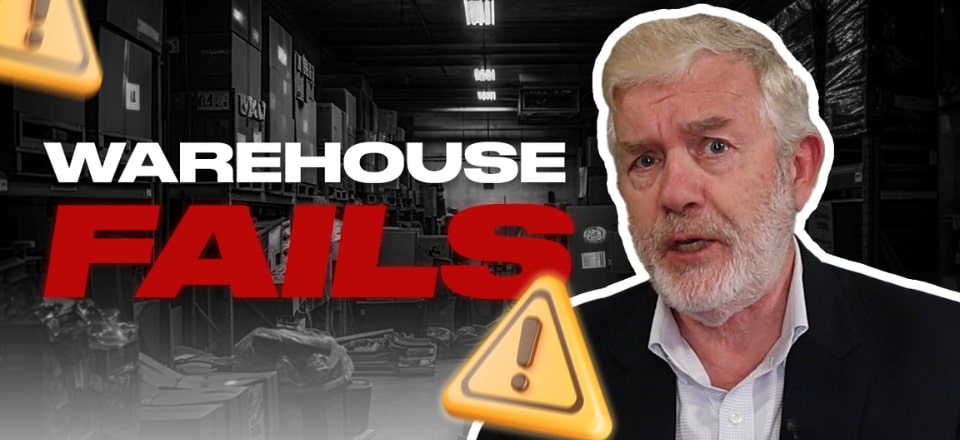There’s been a noticeable increase in demand for assistance with improving warehouse performance.
In this video, we’re tackling key challenges in warehouse management and providing practical solutions.
Additionally, we’re highlighting signs of poor warehouse performance to help you stay informed.
Watch the video below to discover actionable steps to elevate your warehouse operations.
We’ve been tackling numerous warehouse performance issues over the past couple of years. This week, I want to delve into the causes, symptoms, and solutions for these problems.
We’ve audited dozens of warehouses recently, with clients facing capacity issues and escalating costs. We’ve dedicated a lot more time than usual to these audits, so I thought I’d share some background and what we’re doing to help you resolve your warehouse challenges.
Why do these issues arise? We’ll discuss that, the solutions, and the symptoms to watch out for.
What are some of the issues?
Running Out of Space
One of the main issues we’ve encountered is clients running out of warehouse space. Recently, I visited an incredibly packed warehouse in Australia, surpassing even one in Malaysia at 115% capacity. When clients approach us with space concerns, they often seek new warehouse designs or redesigns. However, the first step is usually to review what’s stocked and the inventory policy.
Clients often ask how full a warehouse can be. While I’ve seen one at 115% capacity, operations typically start to feel constrained at 85-95% capacity. For instance, in a warehouse designed for 10,000 pallets, issues arise around 9,000 pallets, limiting activities like product movement, receipting, and dispatching. Operating a warehouse at 100% capacity is challenging, though some manage it. Generally, 85-95% is considered the practical limit, depending on storage methods. Capacity concerns are the primary issue clients seek our help with.
Performance
Performance issues have really stood out lately, especially when it comes to accuracy in picking and inventory management. It’s not just about speed; I’ve come across some pretty inefficient picking operations recently that left a lot to be desired. One big issue that keeps cropping up is poor stock management, or as some call it, “slobex” (slow, obsolete, and expiring stock). It’s critical to stay on top of this to keep your inventory lean and efficient. From my experience visiting countless warehouses, you can immediately tell how well-managed the inventory is by simple tests like checking for dust accumulation on boxes.
Increasing Costs
Another common concern clients approach us with is increasing costs. When you delve into the operations, various factors can contribute to these rising expenses—shifts in order profiles, product changes, or even shifts within the warehouse setup itself. Recognizing these symptoms is crucial for pinpointing areas needing improvement in your own warehouse.
What are some effective solutions to address these challenges?
Layout
A significant factor influencing warehouse performance is its layout, tailored to how products flow through. Different layouts—like U flow, where products enter, are stored, picked, and dispatched on the same side, or T flow, where products enter on one side and exit on the opposite—can greatly impact efficiency.
For instance, we had a client facing capacity issues considering a new warehouse until we noticed their wide aisles. By simply adjusting aisle widths and switching to articulated forklifts, they gained 30% more capacity without needing a new facility. This change didn’t just optimize space but also enhanced material handling efficiency.
Choosing the right storage media and optimizing layout can significantly boost warehouse performance, especially in picking operations.
Processes
When it comes to warehouse processes, efficiency is key. Are you using modern methods like goods-to-person, or are pickers still navigating manually? How products are laid out in your warehouse significantly affects pick paths—a topic I remember well from my logistics studies. It’s surprisingly complex, with researchers even studying pick path algorithms.
Technology
I’m cautious about technology hype. Before jumping into the latest gadgets, it’s crucial to crunch the numbers and ensure a solid business case. Whether it’s cutting-edge solutions or simpler tech, it should be a practical fit for your warehouse’s unique needs.
Inventory
Getting inventory right is crucial. Are you using ABC analysis to manage stock levels effectively? Ensuring inventory accuracy through robust cycle counting is vital to prevent picking errors and operational disruptions.
Slotting
Slotting is a game-changer. By organizing your warehouse like a well-stocked fridge—frequently picked items up front, less used items in the back—you can significantly boost productivity. Using specialized software, we’ve seen productivity gains of up to 15-20% by minimizing pickers’ travel distances.
By optimizing these areas—processes, technology adoption, inventory management, and slotting—you can make substantial improvements in warehouse efficiency and performance.
For detailed information of this topic, watch the video above.
Related articles on this topic have appeared throughout our website, check them out:
- Warehouse Product Slotting: The Ultimate Guide
- KPIs for Your Warehouse: How to Choose and Use Them
- Planning a Warehouse Network and Design: Key Factors to Consider
- 10 Proven Principles for Best Warehouse Design and Operation
- Improve your Warehouse Productivity Through Product Slotting
Editor’s Note: The content of this post was originally published on Logistics Bureau’s website dated March 06, 2024, under the title “Warehouse FAILS – Common Warehouse Management Problems and Solutions“


